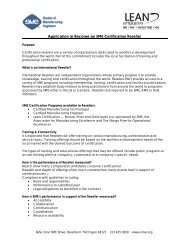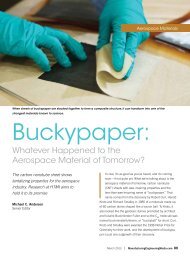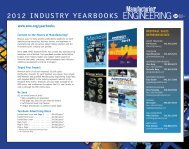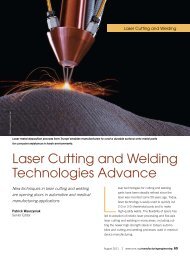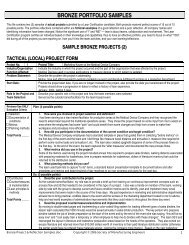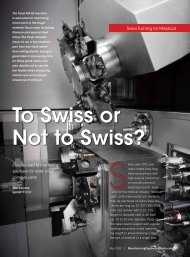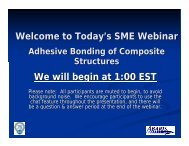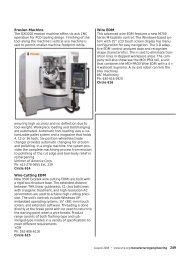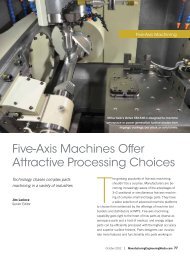The RAPID 2013 Conference & Exposition Directory - Society of ...
The RAPID 2013 Conference & Exposition Directory - Society of ...
The RAPID 2013 Conference & Exposition Directory - Society of ...
Create successful ePaper yourself
Turn your PDF publications into a flip-book with our unique Google optimized e-Paper software.
ConferenCe Details<br />
supported and the end products must achieve or surpass state<strong>of</strong>-the-art.<br />
We will demonstrate the first commercially available<br />
tool with combined heterogeneous capability <strong>of</strong> plastics and<br />
metals for electronic applications and specifically RF electronics.<br />
1:30–1:55 pm<br />
Sky’s the Limit: Advanced Rapid Prototyping<br />
with Multi-material Capabilities<br />
Susan York, US Consumables Business Manager, Stratasys<br />
Innovative Applications<br />
1–3:25 pm<br />
Out <strong>of</strong> the box thinking leads to new ways <strong>of</strong> using additive<br />
manufacturing. This session is a place to hear from innovators<br />
who are testing and doing the unimaginable.<br />
1–1:25 pm<br />
3D Imaging and Forensic Reconstruction<br />
<strong>of</strong> the Human Face<br />
Shayne A. Kondor, Medical Modeling Engineer,<br />
Naval Postgraduate Dental School<br />
Joe Mullins, Forensic Artist,<br />
National Center for Missing and Exploited Children<br />
<strong>The</strong>re are over 100,000 missing persons in the United<br />
States and approximately 45,000 unidentified sets <strong>of</strong> human<br />
remains. A significant proportion <strong>of</strong> the unknown remains are<br />
skeletonized, making identification difficult. DNA and dental<br />
records are extremely useful identifiers, but the dissemination<br />
<strong>of</strong> facial reconstructions, and the subsequent recognition<br />
<strong>of</strong> the unidentified person by an investigative agency, family<br />
member or friend is still one <strong>of</strong> the most common ways that<br />
these individuals are identified. To put a face on these victims,<br />
forensic artists are able to reconstruct a probable face on a<br />
skull using a combination <strong>of</strong> anatomical science and artistic<br />
skill. <strong>The</strong> reconstruction process is classically performed by<br />
clay sculpted over the skull. This process is labor intensive and<br />
expensive. To expedite this process forensic artists now benefit<br />
from 3D scanning technologies, allowing accurate models <strong>of</strong><br />
the skull to be obtained for digital reconstruction <strong>of</strong> the face.<br />
Digital reconstruction <strong>of</strong> the face is performed in a s<strong>of</strong>tware<br />
application. Tangible 3D models <strong>of</strong> the reconstruction are<br />
printed using additive manufacturing technologies. Case studies<br />
will demonstrate different imaging options to obtain a skull<br />
model for the reconstruction process, the digital reconstruction<br />
process, and the additive manufacturing options used to obtain<br />
physical models.<br />
One <strong>of</strong> the major challenges in the prototyping stage <strong>of</strong> product<br />
development is to produce a fully-representative model <strong>of</strong> the<br />
intended end-product. In many industries, this is complicated<br />
by the fact that the final product is not <strong>of</strong> a single, homogenous<br />
material, but is rather an assembly <strong>of</strong> different materials and<br />
properties. Objet inkjet-based technology is the only 3D printing<br />
technology <strong>of</strong> its kind in the world able to selectively place<br />
different materials in a single 3D printed prototype and compose<br />
two materials to create varying composites, Digital Materials, to<br />
closely match very specific material properties. With over 100<br />
different materials and Digital Material combinations to choose<br />
from, including rigid to rubber-like, opaque to transparent and<br />
standard to engineering plastic performance, the sky is now<br />
the limit to creating accurate prototypes that match closer than<br />
ever before the aesthetic look, tangible feel and true function <strong>of</strong><br />
complex end-products.<br />
2–2:25 pm<br />
Making Stuff in the Connected Age<br />
Mickey McManus, President & CEO, MAYA Design<br />
In <strong>2013</strong>, there are more transistors in the world than grains <strong>of</strong><br />
rice. Each year we make billions <strong>of</strong> computing devices and put<br />
them into nearly every significant thing we manufacture. We<br />
have literally permeated our world with computation. Computers<br />
already vastly outnumber people, but in a few short years, their<br />
number will climb into the trillions. We are quickly learning how<br />
to make those processors communicate with each other, and<br />
with us. Instead <strong>of</strong> information being “in” computers; people,<br />
products, environments, and cultures will begin to live “in” the<br />
information. In this burgeoning ecology, strange new varieties<br />
<strong>of</strong> connected products, services, environments, and people<br />
will proliferate. Atoms and bits will connect in ways nobody<br />
can predict. 3D printing <strong>of</strong> electronic devices is already a<br />
reality. What will manufacturing look like when every sheet <strong>of</strong><br />
printed paper has the computing power <strong>of</strong> the newest iPad®?<br />
When connectivity spreads to ordinary objects and they are<br />
newly vulnerable to viruses or bad updates, complexity will<br />
be inevitable. But untamed, malignant complexity is not. This<br />
54 sme.org/rapid





